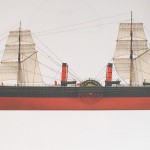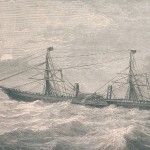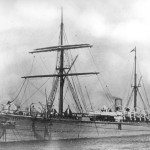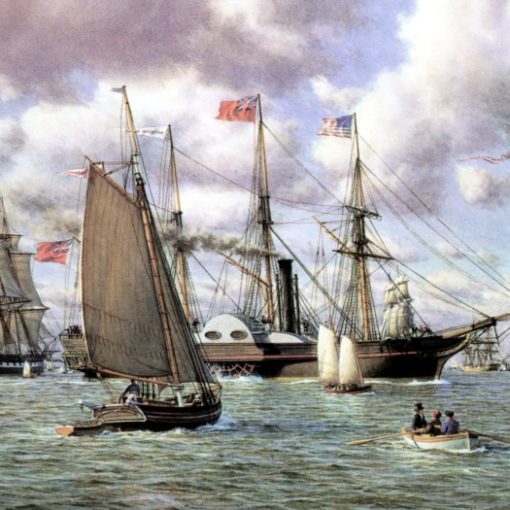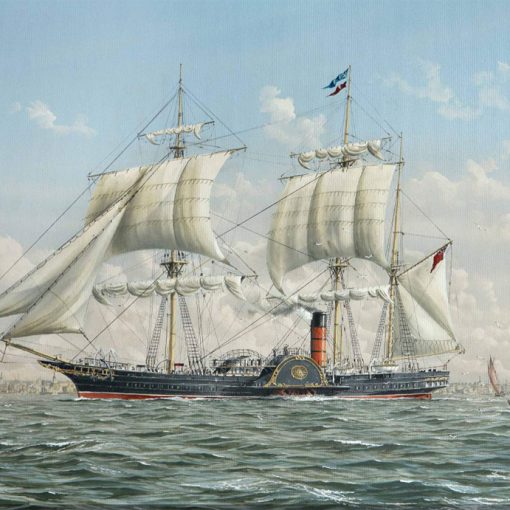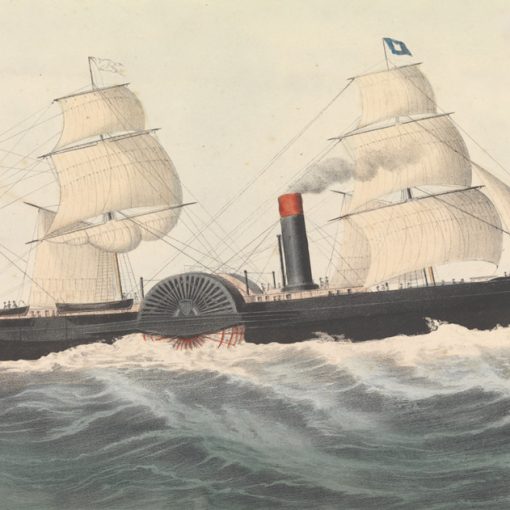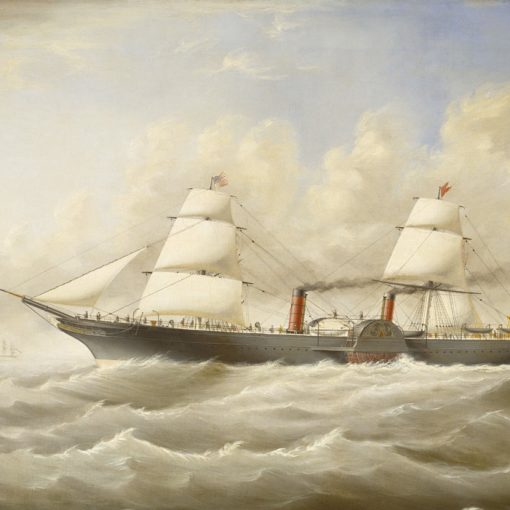1862 – 1904
By the end of the 1850s, steamship design had evolved quite a lot from the early coastal or river boats. In 1840, Samuel Cunard inaugurated his company’s North Atlantic service with the pioneering steamer Britannia. She had a wooden hull, and this design was outmoded when Isambard Kingdom Brunel’s iron-hulled Great Britain entered service in 1845. This ship proved that iron was a better material than wood and that it would allow for even larger ships to be built in the future. In spite of this, it took another eleven years before the first iron-hulled Cunarder entered service in 1856. She was the Persia, and besides being large and modern she had also been built to be a speed queen. It did not take her long to win the coveted Blue Riband in both the western and eastern direction, averaging a speed of over 13 knots.
This was fortunate for the Cunard Line, since they had been faced with fierce competition since the early 1850s. The Collins Line, created by the American Edward Knight Collins, had commissioned new ships, one by one surpassing Cunard’s in both speed and luxury. Persia had been ordered as a response to Collins’ ships, and with her new speed records there finally seemed to be a change of tides in Cunard’s favour.
But although she was a modern ship when it came to her hull design, Persia sported one very conservative feature – paddle wheels. Ever since the early steamship days, there had been debate on whether the propeller was superior to the paddle wheels or not. In an attempt to settle the issue once and for all, the British Admiralty decided to conduct an experiment. In April of 1845, two small steamers were chartered for a simple tug-o-war. The two ships – Rattler and Alecto – were very similar in size and had equally powerful engines. The only significant difference between them was their propulsion arrangements; Rattler had a single propeller and Alecto was equipped with traditional paddle wheels. On a calm sea with no winds, Rattler ended up towing the Alecto at a speed of 2.8 knots. There seemed to be no question about the propeller being superior, and further studies showed that the propeller also made ships more economical to operate.
In addition, the engine arrangements required in a paddle steamer were not very practical. The engines occupied the valuable space amidships, and left little room for steerage quarters. With the increasing emigrant trade in mind, it would be foolish not to build ships with steerage capacity.
But in spite of these seemingly convincing facts, Cunard’s new Persia had been built as a paddle steamer in 1856. However, the company board was not to be blamed alone for this decision. The Cunard Line had a mail contract with the British government, who in their turn tended to follow the advice of older, more experienced sea captains. In this case, conservatism prevailed and Persia became a paddle wheeler.
Cunard had also planned a sister for Persia to be built shortly after her, in order to really give the Collins Line a run for the money. But fate had other things in store for Collins’ company. His ships had a remarkable tendency to get into trouble and accidents. The Arctic was lost in 1854 and two years later the Pacific vanished without a trace in mid-Atlantic, with over 180 people on board. The Collins Line lost the public trust, and the fact that Persia collided with an iceberg the following month but managed to stay afloat and reach New York made the passengers choose Cunard for their crossings. Collins was out of the game.
So Cunard really did not have to rush the building of the new ship. But, the unfortunate accidents that Collins Line had suffered had really brought attention to the matter of maritime safety. Although Cunard had always held safety as a top priority, the high safety standards of the Persia would be improved on her sister ship. And just like Persia, the new ship would be built by the shipbuilding firm of Robert Napier & Sons, Glasgow.
On June 25th 1861, the new vessel was launched and christened Scotia. Like her older sister, she was a paddle steamer with two funnels and two masts. In fact, she had been designed with three masts, but one was removed during the construction. The two ships were not identical, since Scotia was slightly larger and longer. And then there was the case of safety arrangements. Scotia’s hull was divided into seven compartments by six transverse, watertight bulkheads. She had a double bottom, and her hull was considered by many to be the strongest yet built. This had been achieved through very heavy framing, with frames 7 to 10 inches thick only 21 inches apart.
But before she could enter service for Cunard, the Scotia had to go through her sea trials. These were performed quite satisfactory in March of 1862, and the ship managed to reach 13.5 knots. It was however expected that she would reach higher speeds once her engines had been properly run in. Her manoeuvrability also turned out to be very good, when she was easily moved around in the Mersey within her own length. Apparently, someone on board is to have stated that she was “as stiff as a church”. And so, just a little short of a year after her launch, Scotia was ready to set out on her maiden voyage. On May 10th 1862, she left Liverpool for New York as flagship of the Cunard fleet. In command was Captain Judkins, commodore of Cunard Line, who had been transferred from the Persia.
Being a paddle steamer, Scotia did not have any steerage quarters. She had been designed as a First Class ship only. Her passenger cabins were located along the maindeck, each being nine feet in height. Scotia could also offer several public areas, such as the Fore Saloon (45 feet long, 20 feet wide and 8 feet high) and the Main Saloon (62 feet long, 20 feet wide and 8 feet high). They were both lighted from the sides by plates of glass placed in the alternate panels, together providing dining space for 300 passengers. To provide for her passengers during the crossings, Scotia was also equipped with a bakery, a butcher, a doctor’s shop and an icehouse to mention a few facilities. Above decks, there was a promenade reaching from stem to stern.
Scotia soon settled into her service on the North Atlantic, gathering quite a loyal following. When her engines had been run in, she managed to beat the Persia’s westbound speed record in July of 1863, and the eastbound record the following December, both times averaging more than 14 knots. Since Cunard did not have a real competitor at this time, Scotia’s records would remain unchallenged for another six years.
However, no matter how fast and luxurious she was, the paddle-wheel arrangement was somewhat of a burden to Scotia. Her great consumption of coal made her very expensive to operate, and the fact that she only had First Class accommodations made it impossible for Cunard to use her for the emigrant business. Financially, she was not very successful. In fact, Cunard even lost money on some of her voyages. But, she and her sister were very loved ships among many travellers.
Eventually, the technological progress caught up with Scotia. In 1869, she lost the eastbound speed record to Inman Line’s City of Brussels – a 3,081 gross ton, single-screw steamer. The westbound honours remained hers for another three years, but finally she had to give that up to the brand-new White Star liner Adriatic in May 1872. Adriatic was a state-of-the-art, single-screw liner with a sleek hull, a design that made the Scotia look hopelessly old-fashioned and outdated. It would be another 13 years before a Cunarder would hold the Blue Riband again.
Scotia stayed with Cunard for another four years, but by 1876 it was no longer possible for the company to keep her in service anymore. The Russia, a single-propeller steamer that had entered service in 1867, showed that the paddle-steamers were definitely inferior. Cunard wanted a fleet of modern ships, and thus there was no place for Scotia anymore. Her sister, Persia, had been scrapped in 1872, and now the future looked grim for Scotia too. In May of 1876, Cunard’s last paddle steamer was laid up.
For three years she remained in lay-up, awaiting her future. Then, in 1879, she was purchased by the Telegraph Construction & Maintenance Company for conversion into a cable-layer. All of a sudden with a new career in sight, the Scotia was sent to the Birkenhead yards of Laird for the extensive refit. She emerged as a completely different ship, re-engined with one of her funnels removed, and her paddle wheels replaced by two propellers. Her tonnage had increased to 4,667 gross tons and since she was no longer intended to break any speed records, her service speed had been brought down to a modest 11.5 knots.
And so, Scotia settled into a second career, this time employed to lay telegraph cables. Obviously not as glamorous as the North Atlantic passenger trade, she did experience a few dramatic incidents. In 1896, while 60 miles off Eddystone, an explosion in her cable anti-fouling paint store caused serious damage to the ship’s bow. Fortunately – probably thanks to the safety design from her Cunard days – Scotia managed to stay afloat and reach port. After repairs had been carried out, she was back in service again soon.
Scotia survived into the 20th century, and in 1902 she was sold to the Commercial Cable Company for use as a repair ship in the Pacific Ocean, based at Guam. However, after only two years with her new owners, on March 11th 1904 the ship ran aground on Spanish Rock on Catalan Bank off Guam, while en route to Honolulu. Luckily, Scotia’s design proved reliable once again. Stuck on the reef amidships, with both ends free, the ship’s iron hull managed to withstand the immense strain until everyone on board had been rescued. But the hull could not take such stress much longer, and before salvage could begin, the Scotia broke her back and sank during a storm two weeks after the initial grounding.
Scotia remained where she had sunk, and around 1910 a salvage team managed to recover all engine apparatus, with the exception of the crankshafts. In the process, she was blasted flat from midships forward. Today, the remains of the Scotia lies at a depth of 30 feet. Sitting upright, there are still a few things recognisable from her glory days. The counter stern is still there, as well as the double bottom and one boiler.
Specifications
- 400 feet (122.2 m) long
- 47.8 feet (14.6 m) wide
- 3,871 gross tons
- One two-cylinder side lever steam engine turning two side paddle wheels
- 13.5 knot service speed
- Passenger capacity of 573 people

